Small stellated dodecahedron
In geometry, the small stellated dodecahedron is a Kepler-Poinsot polyhedron, named by Arthur Cayley, and with Schläfli symbol {5⁄2,5}. It is one of four nonconvex regular polyhedra. It is composed of 12 pentagrammic faces, with five pentagrams meeting at each vertex.
| Small stellated dodecahedron | |
|---|---|
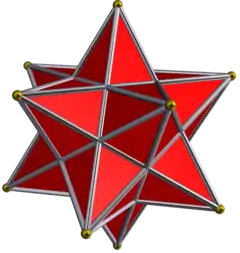 | |
| Type | Kepler–Poinsot polyhedron |
| Stellation core | regular dodecahedron |
| Elements | F = 12, E = 30 V = 12 (χ = -6) |
| Faces by sides | 12 5 |
| Schläfli symbol | {5⁄2,5} |
| Face configuration | V(55)/2 |
| Wythoff symbol | 2 5⁄2 |
| Coxeter diagram | |
| Symmetry group | Ih, H3, [5,3], (*532) |
| References | U34, C43, W20 |
| Properties | Regular nonconvex |
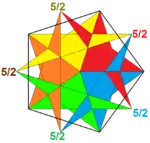 (5⁄2)5 (Vertex figure) |
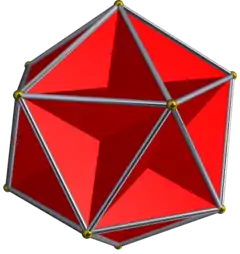 Great dodecahedron (dual polyhedron) |
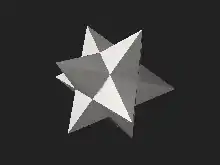
It shares the same vertex arrangement as the convex regular icosahedron. It also shares the same edge arrangement with the great icosahedron, with which it forms a degenerate uniform compound figure.
It is the second of four stellations of the dodecahedron (including the original dodecahedron itself).
The small stellated dodecahedron can be constructed analogously to the pentagram, its two-dimensional analogue, via the extension of the edges (1-faces) of the core polytope until a point is reached where they intersect.
Topology
If the pentagrammic faces are considered as 5 triangular faces, it shares the same surface topology as the pentakis dodecahedron, but with much taller isosceles triangle faces, with the height of the pentagonal pyramids adjusted so that the five triangles in the pentagram become coplanar. The critical angle is atan(2) above the dodecahedron face.
If we regard it as having 12 pentagrams as faces, with these pentagrams meeting at 30 edges and 12 vertices, we can compute its genus using Euler's formula
and conclude that the small stellated dodecahedron has genus 4. This observation, made by Louis Poinsot, was initially confusing, but Felix Klein showed in 1877 that the small stellated dodecahedron could be seen as a branched covering of the Riemann sphere by a Riemann surface of genus 4, with branch points at the center of each pentagram. In fact this Riemann surface, called Bring's curve, has the greatest number of symmetries of any Riemann surface of genus 4: the symmetric group acts as automorphisms[1]
Images
| Transparent model | Handmade models | |
|---|---|---|
 (See also: animated) |
 |
 |
| Spherical tiling | Stellation | Net |
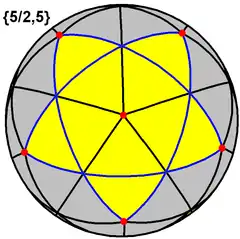 This polyhedron also represents a spherical tiling with a density of 3. (One spherical pentagram face, outlined in blue, filled in yellow) |
 It can also be constructed as the first of three stellations of the dodecahedron, and referenced as Wenninger model [W20]. |
 × 12 × 12Small stellated dodecahedra can be constructed out of paper or cardstock by connecting together 12 five-sided isosceles pyramids in the same manner as the pentagons in a regular dodecahedron. With an opaque material, this visually represents the exterior portion of each pentagrammic face. |
In art

A small stellated dodecahedron can be seen in a floor mosaic in St Mark's Basilica, Venice by Paolo Uccello circa 1430.[2] The same shape is central to two lithographs by M. C. Escher: Contrast (Order and Chaos) (1950) and Gravitation (1952).[3]
Related polyhedra

Its convex hull is the regular convex icosahedron. It also shares its edges with the great icosahedron; the compound with both is the great complex icosidodecahedron.
There are four related uniform polyhedra, constructed as degrees of truncation. The dual is a great dodecahedron. The dodecadodecahedron is a rectification, where edges are truncated down to points.
The truncated small stellated dodecahedron can be considered a degenerate uniform polyhedron since edges and vertices coincide, but it is included for completeness. Visually, it looks like a regular dodecahedron on the surface, but it has 24 faces in overlapping pairs. The spikes are truncated until they reach the plane of the pentagram beneath them. The 24 faces are 12 pentagons from the truncated vertices and 12 decagons taking the form of doubly-wound pentagons overlapping the first 12 pentagons. The latter faces are formed by truncating the original pentagrams. When an {n⁄d}-gon is truncated, it becomes a {2n⁄d}-gon. For example, a truncated pentagon {5⁄1} becomes a decagon {10⁄1}, so truncating a pentagram {5⁄2} becomes a doubly-wound pentagon {10⁄2} (the common factor between 10 and 2 mean we visit each vertex twice to complete the polygon).
| Stellations of the dodecahedron | ||||||
| Platonic solid | Kepler–Poinsot solids | |||||
| Dodecahedron | Small stellated dodecahedron | Great dodecahedron | Great stellated dodecahedron | |||
|---|---|---|---|---|---|---|
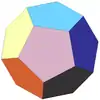 |
 |
 |
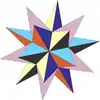 | |||
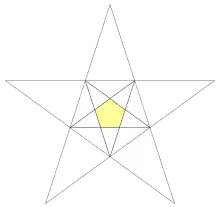 |
 |
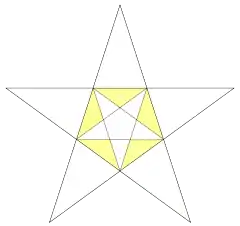 |
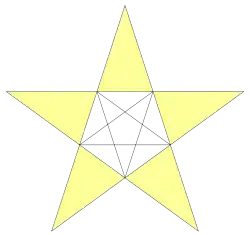 | |||
| Name | Small stellated dodecahedron | Truncated small stellated dodecahedron | Dodecadodecahedron | Truncated great dodecahedron |
Great dodecahedron |
|---|---|---|---|---|---|
| Coxeter-Dynkin diagram |
|||||
| Picture |  |
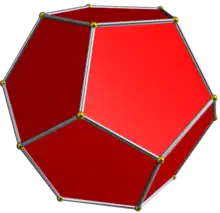 |
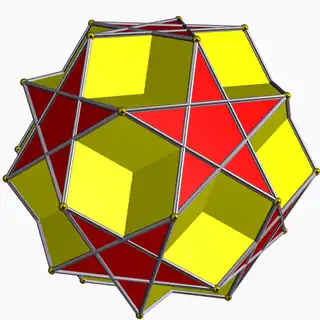 |
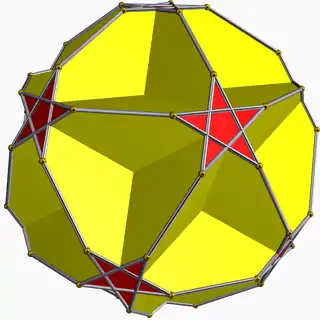 |
 |
References
- Weber, Matthias (2005). "Kepler's small stellated dodecahedron as a Riemann surface". Pacific J. Math. 220. pp. 167–182. pdf
- Coxeter, H. S. M. (2013). "Regular and semiregular polyhedra". In Senechal, Marjorie (ed.). Shaping Space: Exploring Polyhedra in Nature, Art, and the Geometrical Imagination (2nd ed.). Springer. pp. 41–52. doi:10.1007/978-0-387-92714-5_3. See in particular p. 42.
- Barnes, John (2012). Gems of Geometry (2nd ed.). Springer. p. 46.
Further reading
- Wenninger, Magnus (1974). Polyhedron Models. Cambridge University Press. ISBN 0-521-09859-9.
- Weber, Matthias (2005), "Kepler's small stellated dodecahedron as a Riemann surface", Pacific J. Math., 220: 167–182, doi:10.2140/pjm.2005.220.167